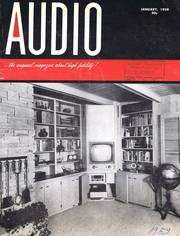Erläuterungen zu diesen US-AUDIO Seiten der 1950er Jahre
Die hier stehenden amerikanischen Artikel aus 1959 (aus der US-AUDIO) sind teilweise sehr gewöhnungsbedürftig, weil sie erstens aus einer längst vergangenen Zeit stammen und zweitens, weil dort in den USA ganz "anders" gedacht wurde als bei uns in Old Germany oder in Europa.
Vergleichbar mit unseren deutschen Hifi-Magazinen etwa ab 1962 ist jedoch, daß auch dieses Audio-Magazin ihre Anzeigen- Kunden und -Leser am Markt oder von anderen Magazinen (be- oder ab- ?) werben mußte. - Weiterhin sind die riesigen Dimensionen des amerikanischen Kontinents mit unseren hier in Europa nicht vergleichbar. - Ein Redaktions-"Trip" von New York nach Los Angeles oder Chicago oder gar in die Wüste nach Las-Vegas zu einer der CES- Audio- "Shows" war - auch mit dem Flugzeug - immer noch eine halbe Weltreise. Und jede Ausstellung oder "Messe" wurde als "Show" deklariert. Und natürlich, in USA musste alles "Show" sein, um beim Publikum einige Aufmerksamkeit zu erzeugen.
.
ABOUT MUSIC - "Audio in the Theatre"
von HAROLD LAWRENCE
Customer: May I have that new album of carillon music you've got in your window?
Salesman: Would you like the "mono" or the "stereo" version?
Customer (after some deliberation) : I'll take the monophonic. After all, how stereo can chimes be? (in etw : Wie kann Stereo bei Musik funktionieren ?)
The customer in this true conversation might seem a bit uninformed in our audio-enlightened age, but don't judge him too severely. He may have little more than a hazy idea as to what constitutes an authentic stereo recording, but he seems roughly aware of basic differences between mono-phonic and stereophonic sound.
And, as any record salesman will tell you, the average record buyer thinks of the stereo disc as having made obsolete the "hi-fi" record.
Bei dieser Ignoranz kan man nur noch zucken
Dedicated audio enthusiasts wince at these now familiar manifestations of the prevailing ignorance over the meaning of stereo and sound reproduction generally. Lack of knowledge on the part of the general public can be excused.
There is no excuse, however, for the failure of those people engaged in the business of entertainment to take full advantage of the enormous strides which the manufacturers of audio equipment and the sound engineers have made over the years toward better and truer sound reproducing techniques.
Ein unscharfer Kinofilm und die Reaktionen
Have you ever noticed the reaction of a movie audience to a film that is poorly focused? Before the operator has had a chance to grab the focusing knob, foot-stamping, whistles, catcalls, and raucous shouts fill the theatre.
But offer this same audience galloping audio distortion and it will sit back, thoroughly relaxed, contentedly munching chocolate-covered peanuts.
Where it concerns audio in public places, the general public is strangely oblivious to the most flagrant abuses.
Speech Reinforcement - am Beispiel Edith Piaf
Some six years ago (also etwa 1945), the diminutive (winzige) French popular singer, Edith Piaf, made her Carnegie Hall debut. Those who were not familiar with her career in the Parisian "music-halls" thought that she had made a serious mistake in hiring such a large hall for her one-man show.
How could she hold an audience's attention for an entire evening; and wouldn't her warm and vibrant personality be dissipated in Carnegie Hall's vast oceans of space?
Die Kritiken lagen falsch an beiden Annahmen
The critics proved wrong on both counts. La Meme Piaf appeared on stage wearing her simple black dress. With her hair combed in no special manner, she looked the antithesis of the "glamour girl." But she needed no accessories to conquer her public; even before she began her first number, she had each person in the hall sitting on the edge of his seat, thoroughly captivated by Piaf's wonderfully expressive features.
For this listener, however, the spell was broken (wir sagen : der Zauber war gebrochen) once the concert began. Piaf, it seems, thought it necessary to employ a microphone throughout the program, though there was no need for electronic amplification.
The orchestra was placed discreetly behind a curtain toward the rear of the stage; but even if it were right out there alongside her, Piaf would never have been in real trouble.
In any contest betweeen the chanteuse and a band, the former's impressive lung power would easily have enabled her to soar above the competition.
Wenn das Mikrofon-System nicht richtig funktioniert
Apart from the fact that the microphone could have been dispensed with, Piaf, unlike such skilled microphone manipulators as Jean Sablon, misused the instrument.
In fact, she did everything but bite it; her "p's" exploded like minor charges of TNT, her "s's" resembled an overworked boiler, and her high notes shattered like the cymbal clashes of the Coldstream Guards.
The result was a sonic nightmare created by the artist's unprofessional use of the microphone and the poor quality of the playback system in the hall.
Solche unglücklichen Zusammenhänge gibt es oft.
This unfortunate pattern of audio distress is a familiar part of the night club and theatrical world.
One of the more disturbing aspects of the contemporary legitimate theatre is the use of tape and disc recording for background and incidental music.
Off-Broadway producers frequently utilize classical records, seldom with any marked success. For example, Respighi's highly evocative "Pines Near A Catacomb" from Pines of Borne preceded Act II of "The Playboy of the Western World" at the Cherry Lane Theatre's revival of Sean O'Casey's play a few years ago.
The choice of Respighi's score could not have been more inappropriate to the Irish subject. To make matters worse, the playback equipment was of shockingly poor quality; the record itself sounded as if it had been borrowed from a circulating disc library; and the system was being played at an abnormally high level for a theatre whose seating capacity is approximately 300 seats.
Broadway Live Produktionen haben oft Sound-Probleme
On-Broadway productions have their audio problems, too, despite higher budgets. When Paul Bowles composed evocative incidental music for Tennessee Williams' "Sweet Bird Of Youth", the entire score was recorded in advance (im Vorfeld) of the play's opening to be played back in recorded form during the run of the production.
Paul Bowles' intention was to convey the special haunting "music" of a lazy Gulf town. He would have succeeded brilliantly were it not for the fact that an inferior playback system and an unreasonable choice of playback level combined to transform the subtle effects he aimed for into loud and vulgar sounds.
Das Bolshoi Theatre Ballet im letzten Monat
Last month, the Bolshoi Theatre Ballet Company concluded its triumphant New York visit. One of the highlights of its run was Prokofiev's Borneo and Juliet.
The crush for tickets was overwhelming, and several hundred thousand requests for seats were actually turned down. One of New York's art movie houses jumped on the Bolshoi bandwagon by presenting a filmed version of Prokonef's ballet with the same company.
The sound track was totally unworthy of the film's visual attributes, which were truly impressive.
"Art" Film Sound
It is a sad commentary (trauriger Kommentar) on the "art" film to note that the sound engineering lavished on a "Western" is usually superior to nearly all "cultural" cinematic efforts, a notable exception being Walt Disney's Fantasia.
Perhaps the public that attends art movies and the legitimate theatre (as well as opera, ballet, and symphony concerts) is, on the whole, indifferent to good sound reproduction.
How else can one account for its permissive attitude towards inferior recording and playback techniques ? The answer may be found in the history of recording.
In the 1880-odd years since Edison devised his tin-foil phonograph, listeners have been content to accept unreasonable facsimiles of "live" performances. To make up for sonic deficiencies, the mind "equalized" the recorded performance.
This form of equalization is undoubtedly still being brought to bear, unconsciously of course, in the above-mentioned cases, as well as in countless other similar situations.
The fact that the public makes this mental adjustment to mediocre sound indicates that it does not expect good sound - that is, the standard of quality of which today's burgeoning audio world is fully capable of producing. If it expected it, it would certainly demand it.
- Anmerkung : Eine etwas frustrierte Meinung aus 1959.
.



